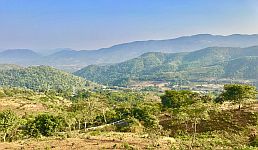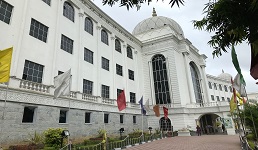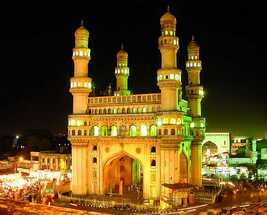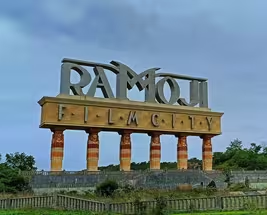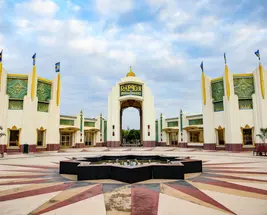One of the nation’s newly formed states has roots dating back centuries and a history embellished in intrigue and wonder. Telangana is potpourri of old-world charm, with a smattering of modernity. The region is synonymous with its breath-taking Islamic architecture, mouth-watering cuisine and vivacious Telugu cinema. And let’s not forget the vast national parks, magnificent waterfalls and rich paddy fields. Telangana Tourism is indeed spectacular and is a must visit places
If you’re in the midst of planning a holiday to this fascination destination, let us help you. The first of many things you’d have to consider is what is the best time to visit Telangana. Here’s an easy guide on the state’s climate and weather conditions, equipped with tips and tricks to navigate the seasons successfully.
Peak Season – For a cultural roller coaster ride, head to the diverse state of Telangana between the months of November and February. During this time, one can marvel at the glorious and spearing edifices, tour the glittering markets and tuck into the steaming savouries and sweets, in the confines of a cool atmosphere.
Shoulder Season – July to September
Low Season – March to June
|
Travel Seasons
|
Min/Max Temperature
|
Season
|
|
November - February
|
15-27°C
|
Pleasant
|
|
March - June
|
24-45°C
|
Warm
|
|
July - September
|
21-35°C
|
Moderate-high rainfall
|
Telangana in Winter (November to February)
Temperature – The air temperature during the season of winter generally fluctuates between 15°C and 27°C, although it can sometimes incline to fall to 10°C.
Weather – The weather of Telangana in winter can be described as a tube of refreshing balm to the year-round hot climate. During this time, the state experiences pleasant temperatures that rarely exceed the 30-degree range. While the days are lovely and crisp, early mornings and nights can get particularly cold. In general, the climate is cool and dry and marks the best season to visit Telangana in for sight-seeing and exploration.
Significance – Telangana is blessed with exquisite architecture, in the form of mosques, mausoleums, monuments and palaces. Furthermore, it boasts sumptuous cuisine and vibrant textile and art. During the wintry windswept days, individuals can enjoy a plethora of offerings, be it cultural or recreational.
Why you should visit now – Winter is the most comfortable period for individuals to be out and about, drinking in the sights and navigating the diverse topographies and cityscapes of the state. This is a delightful time to soak in all the unique charm, without the hassles of heat, humidity and rain. From the delicious nip in the air to the thrilling aspect of wind-in-your-hair, this season was built for vacationing. And what better time to discover a culture so rich and fascinating!
Things to know before the visit –The state of Telangana is susceptible to a natural phenomenon known as the Cold Wave, which affects regions in central India. This condition is a result of cold winds trickling down from the north, after snow and rain have made their presence felt. Take note of the fact that temperatures may fall significantly during this time. On a different note, make sure to book your flight, accommodation and tour packages well in advance as this is peak tourist season. Expect an influx of tourists and higher rates during this popular period.
Tips – Telangana winters range from pleasant to frosty. Although the climate is far from insufferable, that doesn’t mean one dresses skimpily. Long sleeve shirts, pants and sweaters are imperative items to carry. If you’re someone who is prone to feeling cold, throw in a scarf and some vests as well! Furthermore, it’s always helpful to carry moisturizer and lip balm during this season.
Telangana in Summer (March to June)
Temperature – The air temperature during the season of summer fluctuates between 24°C and 45°C, although it may sometimes soar to even 48°C.
Weather – Telangana during summer is much like the state in general – semi arid. With temperatures ascending to the mid 40’s, the climate is cocooned in a perpetual bubble of warmth. The season experiences searing levels of heat and humidity, a particularly unforgiving climate. There is some respite, however, in the form of early mornings and evenings. All in all, this is far from the best climate to visit Telangana in.
Significance – Summers in this blistering state call for some relaxation and indulgences. Individuals can feast on local delicacies such as Sarva Pindi, Sakinalu and Hyderabadi Biriyani, whilst in the comfort of a lovely hotel. During the evenings, one can explore the glittering markets, tea houses and Sufi shrines.
Why you should visit now – Although most tourists refrain from traversing the state at this time, there are those who can tolerate the heat. If you must visit Telangana, be sure to plan indoor visits to museums and art galleries. This is the perfect time to enjoy charming hotels, boutique accommodations, fine dining restaurants and other modern offerings of the state’s bustling capital – Hyderabad.
Things to know before the visit – The months of April to June are prone to the climatic condition of heat waves – a period of excessively hot weather. This means that individuals are at high risk of heat exhaustion and heat strokes. Keep this in mind while planning a trip to Telangana. On a brighter note, this is off season. As such, costs will be lower. If you’re a budget traveller, this is a great time to optimise on ticket, tour and accommodation prices.
Tips – It’s important to take summer precautions, as the climate and weather conditions are extremely harsh. Which means, one must pack light cotton clothing to prevent stickiness and irritation of skin. SPF 30+ Sunscreen will help alleviate sun burn and tanning. A hat and sunglasses will help protect individuals from the blazing sun and enable comfortable outdoor excursions! Lastly, one must keep hydrated through the day and consume light meals.
Telangana in Monsoon (July to September)
Temperature – The air temperature during the season of monsoon fluctuates between 21°C and 35°C.
Weather – The season of monsoon touches the parched lands of Telangana and blesses it with moisture, a much-needed break from the otherwise arid climate. The region experiences moderate to high levels of rainfall, depending upon the city and town in question. The temperatures fluctuate within an amicable range, allowing for a pleasant atmosphere. This is a beautiful time to observe the sky and clouds, a particularly alluring sight.
Significance – During the monsoon, individuals can truly unwind, relax and spend time with their loved ones. It is the perfect time for long strolls and scenic drives. Furthermore, one can enjoy the facilities of hotels along with its picturesque views. If the weather permits, a trip to the gorgeous mosques and forts are especially wonderful as the architecture takes on new light. In particular, Hyderabad’s Hussain Sagar Lake is exceptionally enchanting during and after showers.
Why you should visit now – Monsoon has a way of spreading its magic, transforming landscapes and plains with immense beauty. Vegetation and greenery become lusher, waterfalls sparkle brighter and the atmosphere takes on a mystical quality. Hues of emerald and violet envelope the scenery, creating a magnificent setting for romance, thrills, relaxation and fun.
Things to know before the visit – You’ll need to monitor daily weather conditions and check the forecast before stepping out. There is risk of excessive rainfall occurring, which may cause flooding and disrupt day plans. As this is shoulder season, you will still discover throngs of tourists traversing the region. Be prepared and make all your bookings in advance.
Tips – Gear up for the wrath of the monsoon Gods! You will need an umbrella, windcheater and rain proof footwear such as gumboots or sandals. We’d also recommend you pack light clothing that is also durable. Shelter all electronic gadgets in plastic bags, especially when out and about. Don’t forget to lather yourself with mosquito repellent, before stepping out! Lastly, refrain from eating at unhygienic street food stalls.
Have you decided on what your best time to visit Telangana is? Now all you have to do is pick from one of Thomas Cook’s exciting Telangana Tour Packages and you can be on your way to the Land of the Gold Minarets and delicious Qubani Ka Meetha! Also, check out more ways on How to reach Telangana








